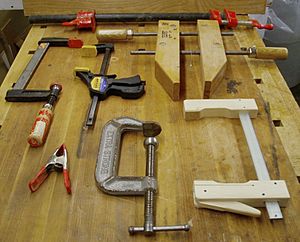Clamp facts for kids
Imagine you're building something, like a cool wooden birdhouse or a model airplane. Sometimes, you need an extra hand to hold pieces together while glue dries or while you're drilling. That's where a clamp comes in handy! A clamp is a clever tool designed to hold things tightly in place, stopping them from moving or falling apart.
Contents
What Are Clamps and Why Do We Use Them?
Clamps are super useful tools that act like strong, temporary hands. They squeeze objects together with force, making sure they stay put. This is really important in many jobs, especially when you need precision or when you're waiting for something to dry or set.
How Do Clamps Work?
Most clamps work using a simple idea: they have two jaws or surfaces that can be moved closer together to grip an object. Often, a screw or a lever is used to apply pressure, making the grip very strong. This pressure holds items firmly, whether you are gluing wood, drilling holes, or holding parts for welding.
Where Are Clamps Used?
Clamps are found in many different places, from workshops to science labs and even in your home!
Clamps in Woodworking
In woodworking, clamps are essential. When you glue two pieces of wood together, you need to hold them tightly until the glue dries. Clamps provide that steady pressure, ensuring a strong bond. They also help hold wood still when you are sawing, drilling, or carving, making the work safer and more accurate.
Clamps in Metalworking
Just like with wood, clamps are used to hold metal pieces together for welding, drilling, or grinding. They help keep everything stable, which is very important when working with hot metal or powerful tools.
Clamps in Science and Medicine
You might also see special types of clamps in science experiments or in medical settings. For example, some clamps are used to hold test tubes in a lab, while others are designed for very specific tasks in surgery to hold tissues or instruments.
Different Types of Clamps
There are many kinds of clamps, each designed for a specific job.
C-Clamps
These clamps look like the letter "C". They have a frame and a screw that tightens a jaw against an object. They are very common and useful for many general tasks.
Bar Clamps
Bar clamps have a long bar with a fixed jaw at one end and a movable jaw that slides along the bar. This allows them to hold very wide objects, making them perfect for furniture making or gluing large panels.
Spring Clamps
Spring clamps are like giant clothespins. They have two jaws that are held together by a strong spring. You squeeze the handles to open the jaws, and the spring holds them shut. They are great for quick, light-duty holding.
Hand Screw Clamps
These clamps have two wooden jaws that are adjusted by two screws. They can grip odd-shaped objects because the jaws can be angled.
Safety Tips for Using Clamps
- Always choose the right size and type of clamp for your project.
- Make sure the clamp is tight enough to hold the object securely, but not so tight that it damages the material.
- Be careful not to pinch your fingers when tightening or loosening clamps.
- Use protective pads on the clamp jaws if you are working with soft or easily marked materials.
Clamps are simple but powerful tools that make many projects easier and safer. They are truly the "extra hands" you need in a workshop!


